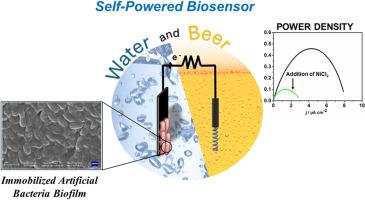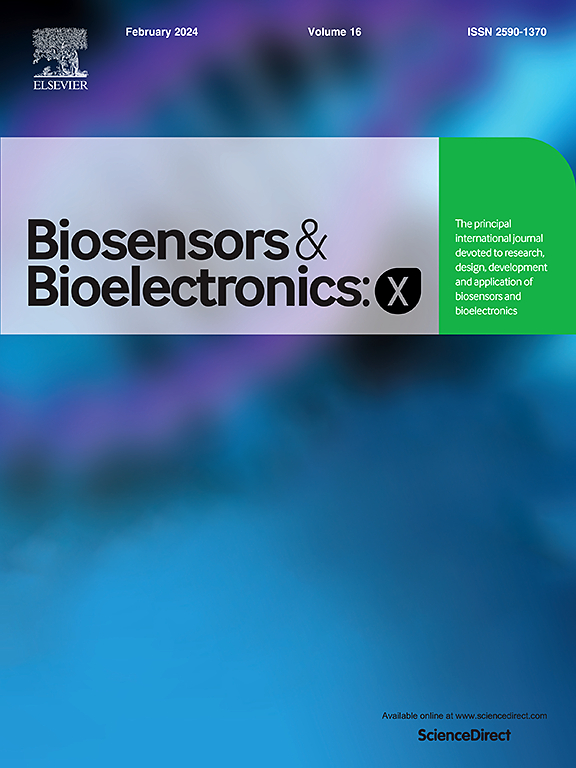基于完整光合细菌的自供电金属离子监测电极
IF 10.61
Q3 Biochemistry, Genetics and Molecular Biology
引用次数: 0
摘要
低成本和早期监测金属离子污染物对于防止水环境大范围污染至关重要。自供电微生物电化学传感器是实现这一目标的有趣方法。紫色非硫细菌具有多功能的新陈代谢和表征良好的光合作用系统,是开发生物杂交技术的理想候选者。在这项工作中,我们报告了在生物光电电极中使用这些细菌开发自供电监测系统的情况,以监测两种常见污染物--NiCl2 和 CuSO4。微生物生物光电电极是在自制的聚羟基丁酸碳纳米纤维电极上获得的,该电极以氧化还原粘附性聚多巴胺基质为基础进行了修饰,其中夹杂着紫色荚膜罗杆菌。500 μM NiCl2 的存在导致电流密度降低了 60%,而同时存在 100 μM NiCl2 和 100 mM CuSO4 则导致 83% 的电流抑制。考虑到生物光电电极在现场的应用,生物杂交系统在含有啤酒的复杂基质中进行了测试,证明了光电化学系统在复杂溶液中充当高效生物传感器的能力。最后,生物杂化电极与一个进行氧还原的阴极耦合,从而获得了一个自供电的监测系统,为将来实施低成本监测系统以广泛监测金属离子污染物铺平了道路。本文章由计算机程序翻译,如有差异,请以英文原文为准。

Intact photosynthetic bacteria-based electrodes for self-powered metal ions monitoring
The low-cost and early monitoring of metal ion contaminants is paramount to prevent widespread contamination of water environments. Self-powered microbial electrochemical sensors represent an interesting approach to achieving this goal. Purple non-sulfur bacteria have a versatile metabolism and a well-characterized photosynthetic system, making them an ideal candidate for developing biohybrid technologies. In this work, we report the use of these bacteria in biophotoelectrodes to develop self-powered monitoring systems for two common pollutants, NiCl2 and CuSO4. The microbial biophotoelectrode was obtained on a homemade poly-hydroxybutyrate-carbon nanofibers electrode modified with a redox-adhesive polydopamine matrix-based entrapping the purple bacterium Rhodobacter capsulatus. The presence of 500 μM NiCl2 resulted in a 60 % decrease in current density, while the simultaneous presence of 100 μM NiCl2 and 100 mM CuSO4 led to an 83 % current inhibition. Given the implementation of the biophotoelectrode in the field, the biohybrid system was tested in a complex matrix containing beer, demonstrating the promising ability of the photoelectrochemical system to act as an efficient biosensor in complex solutions. Finally, the biohybrid electrode was coupled to a cathode performing oxygen reduction, which allowed obtaining a self-powered monitoring system, paving the way for the future implementation of a low-cost monitoring system for widespread metal ions contaminant monitoring.
求助全文
通过发布文献求助,成功后即可免费获取论文全文。
去求助
来源期刊

Biosensors and Bioelectronics: X
Biochemistry, Genetics and Molecular Biology-Biophysics
CiteScore
4.60
自引率
0.00%
发文量
166
审稿时长
54 days
期刊介绍:
Biosensors and Bioelectronics: X, an open-access companion journal of Biosensors and Bioelectronics, boasts a 2020 Impact Factor of 10.61 (Journal Citation Reports, Clarivate Analytics 2021). Offering authors the opportunity to share their innovative work freely and globally, Biosensors and Bioelectronics: X aims to be a timely and permanent source of information. The journal publishes original research papers, review articles, communications, editorial highlights, perspectives, opinions, and commentaries at the intersection of technological advancements and high-impact applications. Manuscripts submitted to Biosensors and Bioelectronics: X are assessed based on originality and innovation in technology development or applications, aligning with the journal's goal to cater to a broad audience interested in this dynamic field.
 求助内容:
求助内容: 应助结果提醒方式:
应助结果提醒方式:


